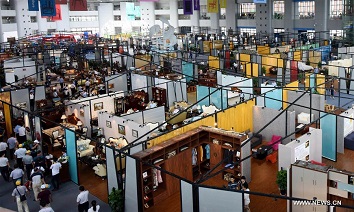Furniture industry at critical turning point
The American furniture industry has faced numerous challenges over the past decade, not the least of which included an economic meltdown, the offshoring of domestic manufacturing operations, and shrinking demand.

The American furniture industry has faced numerous challenges over the past decade, not the least of which included an economic meltdown, the offshoring of domestic manufacturing operations, and shrinking demand. The tide is shifting as economists and furniture insiders express cautious optimism for a slow industry turnaround.
A new Furniture Industry Watch Report has just been released by Anderson Bauman Tourtellot Vos, a corporate transformation consulting firm headquartered here. It provides a snapshot of American furniture manufacturing, offers insights from middle-market retailers about their current view of the industry, highlights challenges the industry is now facing, and identifies possible responses to the challenges. The report is a comprehensive update of ABTV’s 2013 Industry Watch Report.
The report suggests that the American furniture industry is at a turning point. Never known for its ability to respond quickly to change, the industry finds itself emerging from the Great Recession to face slower-than-expected economic recovery, shifting consumer buying preferences, skilled worker shortages, rising labor costs, technology integration issues, new distribution channels and global competition.
The report points out that the industry is challenged to effectively communicate with multiple generations of consumers and workers in order to match marketing outreach and product preferences to different audiences and bridge the skills gap in order to remain competitive.
Here are highlights of some of the report’s findings.
The tide is turning
The furniture industry as a whole has seen great improvements over the past few years. After a 13% drop in sales in 2009, new furniture orders at U.S. furniture factories have increased a minimum of 4% every year. As of 2013, orders were up 23% from 2009 and up 7% from 2008. This slow but steady increase has carried over into 2014 and is expected to continue for the next several years.
Rethinking offshoring
Many U.S. manufacturers are continuing to review their overseas manufacturing operations as the cost advantages of sourcing products globally starts to diminish. While some foreign manufacturers remain cost competitive, cost advantages are eroding due to wage increases, lagging productivity growth, unfavorable currency values and rising energy costs, according to a survey conducted by The Boston Consulting Group in the first half of 2014.
Furniture manufacturers with current overseas operations should carefully analyze the total costs associated with those operations. It is estimated that manufacturers could be overestimating savings from offshoring by up to 30%.
However, the fact remains that onshoring is not necessarily a panacea. Many foreign manufacturers are still producing at a lower cost, and their quality is picking up.
Manufacturing makeover
As with all sectors of manufacturing, furniture manufacturers are facing skilled labor shortages, too. An aging workforce has depleted the pool of skilled workers in the furniture industry — particularly upholsters and sewers. And fewer younger people are looking for those jobs.
The problem is that the industry is changing, but its image isn’t. Many subscribe to long-held beliefs that associate furniture manufacturing with layoffs, untrained manual labor, and dark and dusty work conditions. The reality is that the furniture industry, as in other manufacturing sectors, is introducing advanced technology into its processes, replacing traditional manual processes with sophisticated machines that operate in clean environments.
The challenge is how to attract and retain qualified labor and overturn negative perceptions of the industry, particularly among younger workers. The answer may lie in the reality that this problem is greater than the furniture manufacturing industry itself — the manufacturing industry in general is in need of a total image makeover.
Hooked on housing
As the housing market goes, so goes the furniture industry. Housing starts are up in 2014, existing home sales have increased, and the sale of distressed homes has leveled off. Correspondingly, new furniture orders have increased and are running ahead of last year’s orders, and shipments are higher compared to a year ago. Many industry experts are predicting that the furniture industry’s slow but steady growth will continue through the end of 2014, provided consumer confidence levels remain high.
According to ABTV’s economic forecaster, Jim Smith, attention needs to be paid to the housing sector, which needs to pick up the pace in order to ensure the ultimate turnaround that the U.S. economy needs. Smith says the pattern of decline into recessions and rebounds before the end of recessions has been obvious for all 11 post-World War II recessions, except for the most recent one. He points out that in 2014, the housing market still isn’t contributing much to real Gross Domestic Product. However, he predicts this will change over the next three to five years, which will be good news for the furniture industry.
Trends driving trends
Over the past decade, many factors have emerged that directly or indirectly affect the furniture industry, including technological changes, the rise of social media, and changing demographics.
Baby Boomers downsizing from traditional five-bedroom family homes to updated three-bedroom townhomes or condos are stunned that their old furniture is not scaled to fit new, sleekly designed contemporary environments and looks and feels dated in new spaces. With Baby Boomers offloading so much of their stuff all at once, the used furniture market has become glutted and nonprofit donation centers have become pickier about what they’ll accept for resale. Inexpensive imports are now an attractive alternative to second-hand furniture and collectibles.
The Millennials or Gen Y are driving their own trends, too. Environmentally friendly furniture trumps furniture made in the U.S.A., smaller is better because it’s more affordable and sized to fit their smaller living spaces, and social media is a critical element in this generation’s bag of research tools used when considering a furniture purchase.
By the year 2020, it is estimated that Millennials will be nearly 50% of the workforce, a reality the furniture industry must recognize as it markets to this consumer group and hires them. This generation thinks, acts and consumes in vastly different ways compared to previous generations and is already shaping a new world order.
Demand dictates distribution
The Internet is changing the furniture retail landscape, particularly among younger consumers, and opening up new channels of distribution. Many retailers, particularly in the lifestyle category, have entered the rapidly growing ecommerce market that offers customers the convenience of purchasing furniture directly from their websites. Increasingly, consumers are more willing to purchase furniture online, sight unseen, and are embracing this new distribution channel. Ecommerce is one of the new frontiers that the furniture industry must embrace.
Looking ahead
The furniture industry is in the process of transformation. The skills gap that exists is one of the big hurdles the industry must find a way to overcome. There is a need to communicate simultaneously with multiple audiences that are now active in the workforce and consumer populations, each with their own set of standards related to product and employment preferences. And, the industry must be willing to innovate and buck trends in order to thrive. Bold decisions made now will create course corrections that can send the furniture industry in the direction of increased profitability, competitiveness and market share for the foreseeable future.
-

Furniture Industry in China Faces the Crisis of Excess Production Capacity
-

West China Furniture Industry Area Faces to the Tertiary Market in Midwest China
-

Ali Design Week: Chen Baoguang (CNFA) with Analysis on China Furniture Industry and Design Development
-

North China Furniture Industry Area: the Largest Distributing Center of Classical Furniture in Northern China

 沪公网安备31010402003309号
沪公网安备31010402003309号



